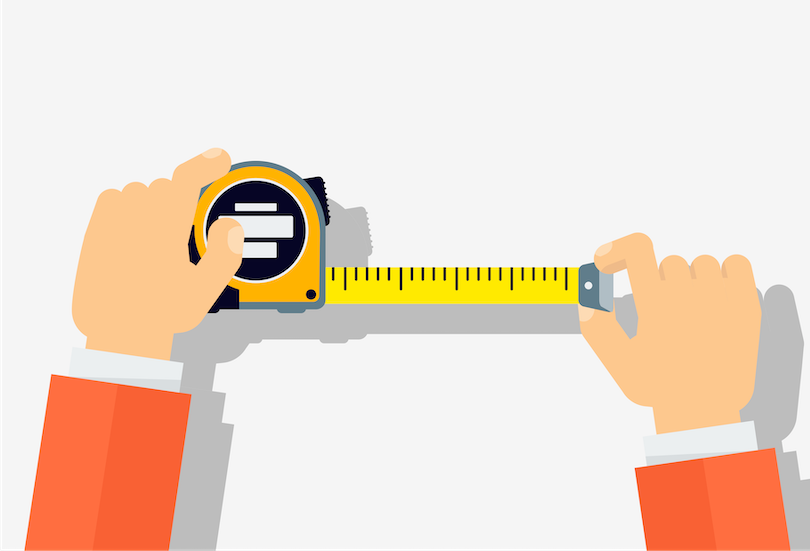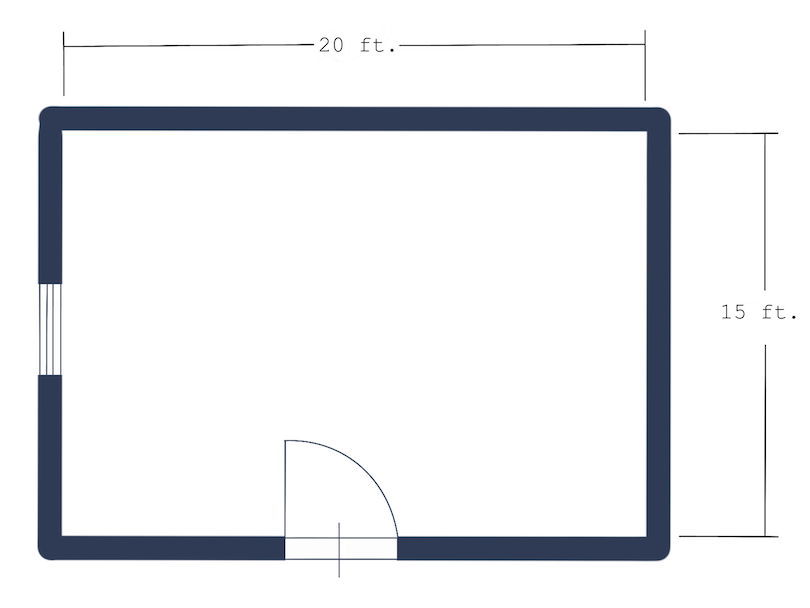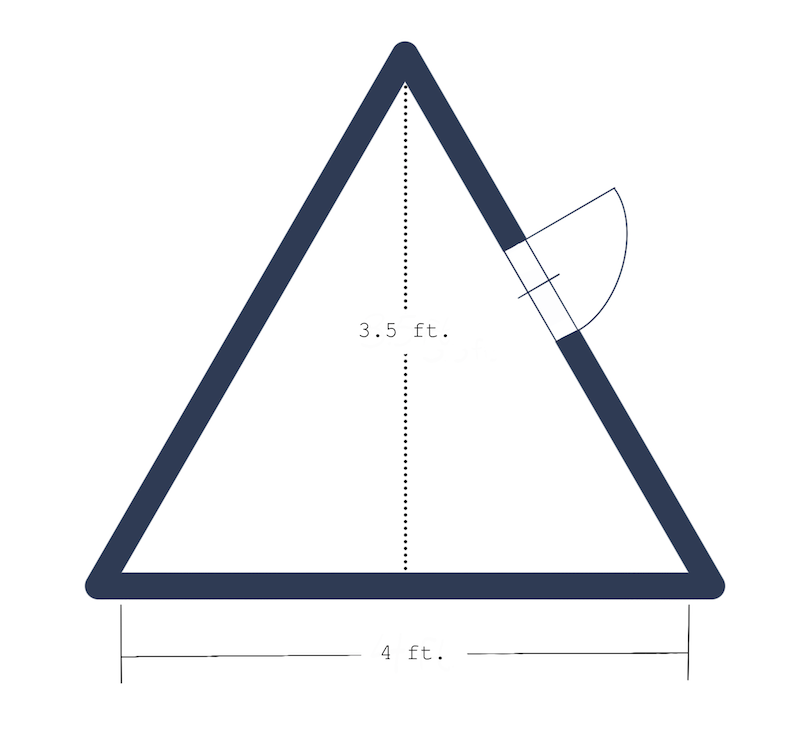Figuring out the square footage of your house is easy. You just calculate the area of each room that counts as gross living area (GLA) — basically, rooms that are above grade and connected to a heating or cooling system — and add them all together.
While that sounds simple — and it is! — some things about the process can get a little complicated. For one, there is no national standard for how to measure square footage of a home. Each state has its own rules, although most follow the recommendations from the American National Standards Institute (ANSI).

A professional appraiser will likely measure your square footage from the exterior walls, which is what the ANSI recommends. But, if you’re doing the calculations yourself, you should measure each room individually and add them together. That way you don’t inadvertently add an area that is considered a non-usable space.
If you need your square footage because you want to sell your house, doing it yourself can give you an idea of how much you can list it for. But beware: if you want to list it using an MLS service, you’ll need the square footage measured by a professional, like an appraiser.
🏡 Sell or Buy a Home with Clever and Save Thousands!
Enter your zip code to see if Clever has a partner agent in your area!
Because things can get a bit complicated, we highly recommend the help of a find an agent for this integral step in the sale or purchase of your home.
JUMP TO SECTION
- How to calculate square footage of a room
- How to calculate square feet of a house
- What counts as square footage?
- Why square footage is important
- How to calculate square footage of a house for appraisal
- How can a real estate agent help?
- FAQs
How to calculate square footage of a room
Calculating the square footage of a room requires some very basic geometry. You’ll need to calculate the area of each room in your house — be sure to only include rooms that count toward your gross living area (GLA) — and add them together.
Before you start measuring, make sure you have the following tools on hand:
- Tape/Laser measure
- Graph paper
- Pencil
- Calculator
Draw a rough sketch of the floor plan for your house. Don’t worry about being accurate. You just need something to help you keep track of all the rooms you’re measuring.
👷 Pro tip! Don’t forget to include closets, pantries, and other small rooms in your plan. They can be easily overlooked, but they usually count toward your total square footage.
Next, start measuring! You’ll use different formulas depending on whether a room is a:
How to calculate the square footage of a rectangular room
Chances are most if not all of the rooms in your house are rectangular. That’s good news, since the area of a rectangle is easy to calculate. All you do is multiply length by width. Or, to put it another way, multiply the length of the longest wall by the length of the shortest wall.
As your geometry teacher would write it:
A = L x W
Where A equals area in square feet, L equals length in feet and W equals width in feet.
Let’s take the following room as an example:

First we measure the length of the longest wall, which is 20 feet by the length of the shortest wall, which is 15 feet.
We then multiply 20 by 15 and get 300. So, the area for this room is 300 sq/ft.
💁 What about alcoves and oddly shaped rooms?
If you have a room with alcoves, fear not! Simply measure the area of the alcove using the same equation as above (assuming it’s a square or rectangle). Then, add the total to the area of the main room.
If you have an oddly shaped room, such as an L-shape, split it into square or rectangular sections and treat them as two separate areas. Not every space is linear, but you can still determine the square footage of an area by dividing it into shapes and calculating each shape's individual area.
How to calculate the square footage of a triangular room
Triangular rooms may sound strange, but they do happen. You may for example, have a corner of a room that has been turned into a closet or pantry.
Fortunately, finding the area of a triangle is very easy. Multiply the length of one side by the height of the triangle and then divide the answer by two.
That might sound tricky, but it’s actually really simple. The following example will show why.

The first step is to measure one side of the triangle. This side will be your base. In the above image, the base is four feet.
We then imagine a perpendicular line traveling from the base to the opposite corner of the triangle. In the above picture, this is the dotted line, which is your base height. In our example, the base height is 3.5 feet
Then we multiply the base by the base height, which gives us 14.
Finally, we divide our answer by two. For our tiny room above, the final answer is 7 square feet.
📐 Calculating the area of a right triangle
Calculating the area of a right triangle — which is a triangle where one corner is 90 degrees — is even easier. Just multiply the two sides that are joined together at the 90 degree corner and then divide the answer by two!
How to calculate the square footage of a circular room
Calculating the square footage of a circular room is a bit more complicated, but it’s still quite easy. If your room is a perfect circle, you can calculate the area by multiplying pi (which is approximately 3.14) by the radius of the room squared.
Still confused? Let’s take an actual example and you’ll see how simple it is!

The first thing you need to do is find the radius of the room. To do that, simply measure from the center of the room to the wall. If you can’t find the center, measure the diameter of the room (i.e., the furthest distance between the walls) and divide it by two.
In our above example, the radius is five meters. So, we square the five — which simply means multiplying five by itself — and get 25.
Then we multiply 25 by 3.14 (again, that’s the rounded figure for pi).
The answer is 78.5. Since we round to the nearest whole foot when calculating the area of a house, we’ll say that the area of the room is 79 sq/ft.
Clever's top-rated real estate agents can help you find out the square footage of your house and provide a comparative market analysis (CMA). A free, no-obligation CMA is a great way to learn how much your house might fetch on the market compared to others of similar size in your area.
Connect with an agent and get a free CMA today!
How to calculate square feet of a house
Double check that you’ve measured every room that counts as gross living area (GLA). Next, to calculate the total square footage of your house, simply add together the area of every room.
Using the measurements from above, we add the areas of the rectangular room, the triangular room, and the circular room, which looks like this:
300 + 7 + 79 = 386 sq/ft
So, assuming that this house only consists of the three rooms we measured, the total square footage is 386 sq/ft.
❗Adding a second story
If you have a second story, don’t just multiply the area of the first story by two. Chances are the non-usable space — which is space that doesn’t count toward total square footage — on your second floor is different from the non-usable space on your main floor.
For example, if you have a two-story foyer, the area it takes up on the second floor is non-usable space. Similarly, your first floor may have a garage — which does not count toward gross living area (GLA) — while your second floor won’t.
What counts as square footage?
| Rooms usually included in square footage | Rooms usually excluded from square footage |
|
|
After you understand the math behind square footage, you then must understand which areas to include in your overall calculation. Total square footage doesn’t include all the rooms or structures on your property, but rather just those that count toward your home’s gross living area (GLA).
There are a lot of rules for determining which rooms are part of your GLA and which ones aren’t — and standards do vary a bit from state to state. A good rule of thumb is that a room is usually a part of your home’s GLA if it:
- Is above grade
- Has finished floors, walls, and a ceiling
- Is heated and/or cooled
- Has a ceiling clearance of at least seven feet
📏 What about beams and ducts?
Don’t worry if you live in a tudor house with large ceiling beams or you have an air duct that cuts across your living room. Spaces beneath beams, ducts, and other obstructions only need a clearance of 6’4 in order to count toward your house’s total square footage. However, the rest of the room will still need a clearance of at least seven feet.
What is included in square footage:
Living and family rooms
As long as your living room or family room is above grade, it counts toward your total square footage. Unfortunately, family and living rooms in the basement usually don’t count, although there are exceptions.
Kitchen
Kitchens count toward your home’s total square footage. That’s good news since the kitchen is considered one of the two most valuable rooms for home buyers, along with the master bathroom. When measuring your kitchen, remember that square footage includes any floor space that is covered by cabinets, islands, or counters.
» MORE: 5 New Construction Upgrades that Add Value in the Long Run
Dining room
Dining rooms absolutely count toward your home’s total square footage, as long as they are above grade and part of the main house.
Bathrooms
All bathrooms that are in the main house and above grade are included in the total square feet of your home. Any surface area covered by a tub, shower, or cabinet is also included in the total area.
Bedrooms
Bedrooms are always included in total square footage so long as they are part of the main house and above grade. When measuring the area of any bedrooms, don’t forget to include closets, as these are also considered a part of the gross living area.
Finished attic
To include an attic in a home's square footage, it needs to be finished and include at least seven feet of clearance space. If the finished attic has a sloped ceiling, at least half of the ceiling must clear seven feet. But only the space that has a clearance of at least five feet can be included in the room’s square footage.
Finished basement (but often not included even if finished)
Basements are usually not included in your home’s total square footage, especially if they are below grade. However, the rules vary a bit from state to state. Usually for a basement to be included in the gross living area, it must be finished and have a door to the outside that can function as a fire escape.
» LEARN: How Much Value Does Finishing a Basement Add to a Home?
Enclosed porch with heating and cooling system (if applicable)
If you have a covered and enclosed porch, you may be able to include it in the square footage count. The porch must be hooked up to the same heating and cooling system as the rest of the home. A good example of a covered, enclosed porch is a sunroom.
What is not included in square footage:
Basement
As a general rule, any structure below grade, or underground, should not be included in the total area, including basements. But as we said above, there are exceptions. These standards will vary by state along with the definition of "below grade." Whether a basement is finished has little to do with its inclusion in the home's square footage.
Even if your basement isn’t included in the square footage, it can still add value to your home. On average, finished basements are in higher demand than ones that need renovations.
Garage
Garages don’t get included in total square footage, unfortunately. However, if your garage has been converted into a proper living space with heating and cooling — and has the proper building permits to show for it — then it is a part of your total square footage. Of course, at that point it is no longer a garage, so it’s a bit of a moot point!
» MORE: How Much Value Does a Garage Add to a House?
Attic
An attic is not included in total square footage unless it is a finished attic and has a clearance of at least seven feet. Buyers will commonly find attics advertised in the home listing even when the space is not considered livable.
Rooms with a sloped ceiling
As we mentioned above in terms of finished attics, rooms with a sloped ceiling may or may not be included in the square footage depending on a few factors. Basically, at least half of the room needs to clear seven feet in order for it to be included. At that point, however, only the area of the room that has a clearance above five feet is included in the square footage. Any space less than five feet is excluded.
Pool house
Pool houses are typically separate from the main house, which is why they don’t count toward total square footage (even if they are enclosed and heated/cooled). But if you’re selling a home with a pool house, definitely promote the fact in your listing. Pool houses are sought after by many home buyers and may be able to fetch you a higher asking price.
Guesthouse
A guesthouse can be a big selling point for home buyers, which is why it can be a bit frustrating to learn that guesthouses are rarely included in total square footage. Just as with the pool house, so long as the guesthouse is separate from the main house, it doesn’t count toward total square footage.
» LEARN: How to Successfully Sell a Home with a Guest House
Separate storage area
Separate storage areas like backyard sheds aren’t included in your home’s square footage. The storage area may add value to your home, but because it is a separate structure and likely not hooked up to the house’s HVAC system, it doesn’t count as a gross living area.
Mother-in-law suite
Detached mother-in-law suites are often fully enclosed and hooked up to an HVAC system. In fact, they may be just as nice — if not nicer — than some of the rooms in your main house. Despite this, you should not include in-law quarters in the square footage calculation unless a connection exists with the main house. As a buyer, consider these "bonus" rooms.
» MORE: How to Buy a House with a Mother-In-Law Suite
Why square footage is important
Square footage has a big impact on listing price. Usually, agents will determine the price to list your home for by comparing it to the list price of homes of a similar size in your area.
Of course, other factors will play a big role as well — including whether rooms that don’t count toward your gross living area (GLA) — have been renovated. But square footage is a useful starting point for estimating how much you can sell your house for.
List price isn’t the only reason square footage is important. Property taxes are often tied to home size. If your local land records office has an incorrect measurement of your home’s square footage, you could inadvertently be paying too much in taxes.
Also, if you want to carry out a major renovation or build an extension to your house, you may need to get a building permit. In many cases, you’ll need to provide the square footage of your house to get a permit.
How to calculate square footage of a house for appraisal
Calculating your home’s square footage yourself gives you an idea of just how big your house is — and how much you may be able to list it for. However, you will probably need to get a professional to do an official evaluation at some point.
To get your home listed on an MLS service, your square footage must come from an approved source, such as an appraiser. Talk to a realtor or your local building department to learn who counts as an approved source in your area. Clever can connect you with a local realtor who can guide you through the process of putting your home on the market.
[inline-image-cta slug="trying-to-find-a-real-estate-agent"]
A professional appraisal also helps avoid awkward and costly scenarios where you mistakenly overestimate the square footage of your house. If you get an offer based on a mistaken square footage, that offer could easily fall through if the buyer hires their own appraiser and learns the true square footage.
One time when you don’t need an official square footage calculated is if you haven’t made any changes to the house since you purchased it. The square footage in the appraisal from that transaction will in all likelihood still be accurate.
You can also find the information in the city's building department, where home builders must submit square footage in their documentation for plans and permits. If your house was newly built when you bought it, that documentation should still be up to date — assuming you haven’t made any renovations or extensions since the purchase.
How can a real estate agent help?
Considering the importance of square footage, first-time home buyers should not be afraid to reach out for help. There are appraisers that specialize in valuing homes in most areas.
For sellers without an agent (commonly known as FSBOs), a well-qualified appraiser is essential for accurately advertising the property. Seasoned real estate agents are familiar with a home's spacing and can often estimate square feet without a tape measure.
Clever has knowledgeable and experienced full-service agents all over the country who would be happy to help answer your questions, including helping you calculate the square footage of a house. They will sell your home for a 1.5% listing fee ($3,000 minimum). Say goodbye to traditional real estate commissions and contact us today!
FAQs
What is included in the square footage of a house?
Most spaces in the home are included in its square footage, including stairways, hallways, and closets. Finished attics will be included if they have at least seven square feet of clearance. Covered and enclosed porches can also be included if they are heated using the main HVAC system.
However, basements or other below-grade spaces are not counted toward a home’s gross living area (GLA), nor are any areas that require you to leave the main finished area of the house, such as garages, guesthouses (casitas), or pool houses.
How does an appraiser determine the square footage of a house?
Most appraisers use a simple technique to determine gross living area (GLA). They measure the exterior of the home. If the exterior measures 30 feet by 40 feet and is one story, the home contains 1200 square feet. This includes all closets, hallways, stairwells, and even wall space since its starting from the exterior. The appraiser will also take into consideration other finished spaces not included in the square footage but usually at a lower price per square foot than the main house.
Does square footage of a house include all floors?
Square footage of a home includes all above-grade floors, usually excluding basements. An attic can be included if there are at least seven feet of head clearance and HVAC.
Are hallways included in square footage?
In the gross living area (GLA) calculation, an appraiser (or someone else) calculates square footage by measuring from the outside, so wall space, stairwells, and even hallways are calculated in the total square footage.
Do closets count as square footage?
Yes. Closets are considered a part of the home’s gross living area. Measure the area of the closet just like any room and include it in the total square footage.
Does square footage include the garage?
No. Garages are not considered a part of a house’s gross living area. However, you can still mention in your listing that your house includes a garage.
How much does an official appraisal cost?
The average is between $300 and $400, but it depends on where you live, how big your house is, and other factors. The range is from $250 to nearly $500.
